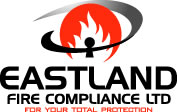-
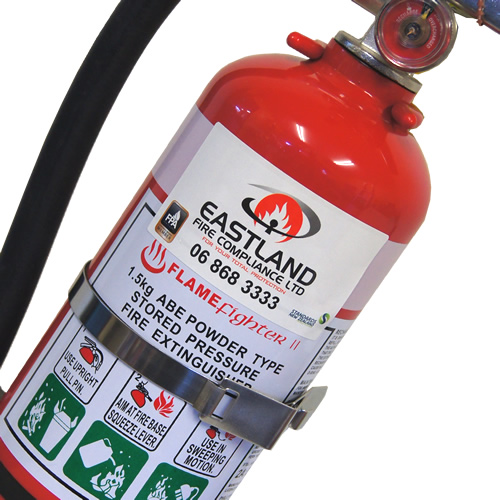 ABE-DRY-POWDERExcellent extinguisher for most types of fires, and a very good extinguisher for novice users.Dry Powder is ABE Rated and the extinguishers themselves are cheap to purchase and lightweight to operate, as well as achieving vey good Fire Kill ratings compared to most other extinguishers because of a very quick knockdown effect. The only downside to Dry Powder is that it is very messy, and the powder (typically Ammonium Phosphate) is mildly corrosive, affecting printed circuitry such as electronic equipment particularly. ABE Dry Powder must never be used in the vicinity of aircraft, as it would be necessary to pull apart the affected area rivet by rivet, piece by piece in order to clean it and prevent corrosion.
ABE-DRY-POWDERExcellent extinguisher for most types of fires, and a very good extinguisher for novice users.Dry Powder is ABE Rated and the extinguishers themselves are cheap to purchase and lightweight to operate, as well as achieving vey good Fire Kill ratings compared to most other extinguishers because of a very quick knockdown effect. The only downside to Dry Powder is that it is very messy, and the powder (typically Ammonium Phosphate) is mildly corrosive, affecting printed circuitry such as electronic equipment particularly. ABE Dry Powder must never be used in the vicinity of aircraft, as it would be necessary to pull apart the affected area rivet by rivet, piece by piece in order to clean it and prevent corrosion. -
 Being a gas, is seeks its way into equipment and will get at a fire in cabinets of equipment and switchboards. Being a gas, there is no clean up after use, and is the only choice for Server rooms, switchboards and Computer suites. CO2 achieves a very light flammable liquids rating, but will not extinguish a Class A fire, as it only displaces the oxygen while it is being operated. Once the flow stops, burning timber paper or textiles will re-ignite.
Being a gas, is seeks its way into equipment and will get at a fire in cabinets of equipment and switchboards. Being a gas, there is no clean up after use, and is the only choice for Server rooms, switchboards and Computer suites. CO2 achieves a very light flammable liquids rating, but will not extinguish a Class A fire, as it only displaces the oxygen while it is being operated. Once the flow stops, burning timber paper or textiles will re-ignite. -
 A very good extinguishant for solely Class A (timber/paper/textile) fires with excellent cooling effect, Water requires little clean-up and is cheap to refill, and is favoured by areas which are likely to have malicious discharge of extinguishers regularly for both reasons. Water however has very negative effect on all other fires, and suffers from being bulky and awkward to handle as an extinguisher, and dangerous to use on both flammable liquid fires (causing nasty eruptions), Cooking media such as deep fryers, (causing dangerous explosions) and Energised Electrical Equipment (able to conduct electricity back to the operator) and must never be used in these situations.
A very good extinguishant for solely Class A (timber/paper/textile) fires with excellent cooling effect, Water requires little clean-up and is cheap to refill, and is favoured by areas which are likely to have malicious discharge of extinguishers regularly for both reasons. Water however has very negative effect on all other fires, and suffers from being bulky and awkward to handle as an extinguisher, and dangerous to use on both flammable liquid fires (causing nasty eruptions), Cooking media such as deep fryers, (causing dangerous explosions) and Energised Electrical Equipment (able to conduct electricity back to the operator) and must never be used in these situations. -
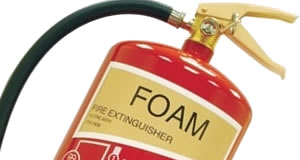 Foam is a very good smothering agent, and works well to control open flammable liquid fires if you have time to work the blanketing effect required, but does not have a fast knock-down like Dry Powder. Foam is also very effective against Class A (timber/paper/textile) fires and achieves a better effect than water because of a higher surface tension. Although some AFFF extinguishers achieved a laboratory test of electrical non-conductivity of the spray, Foam Extinguishers must never be used on Energised Electrical equipment, as this will pool on the floor and remain conductive.
Foam is a very good smothering agent, and works well to control open flammable liquid fires if you have time to work the blanketing effect required, but does not have a fast knock-down like Dry Powder. Foam is also very effective against Class A (timber/paper/textile) fires and achieves a better effect than water because of a higher surface tension. Although some AFFF extinguishers achieved a laboratory test of electrical non-conductivity of the spray, Foam Extinguishers must never be used on Energised Electrical equipment, as this will pool on the floor and remain conductive. -
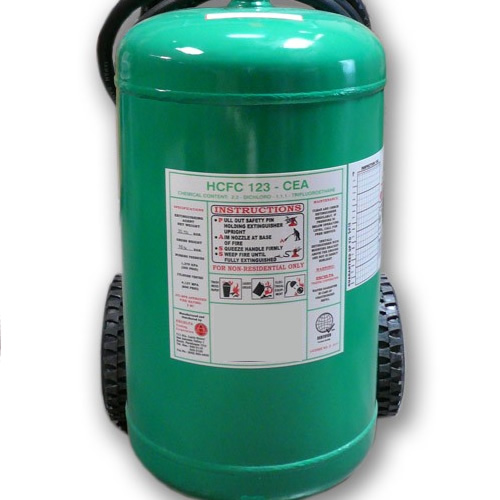 BCF is possibly the most effective extinguishant constructed as is combines with the Oxygen molecule to make an inert gas, smothering the fire invisibly. Unfortunately it is an exceptionally dangerous chemical, as a small amount inhaled can be fatal, and is one of the worst Ozone depletions known to mankind. A small 1kg extinguisher of BCF will deplete a hole in the atmospheric ozone layer 1.5 cubic kilometers in size, and is a banned substance under the Montreal Protocol 1986.
BCF is possibly the most effective extinguishant constructed as is combines with the Oxygen molecule to make an inert gas, smothering the fire invisibly. Unfortunately it is an exceptionally dangerous chemical, as a small amount inhaled can be fatal, and is one of the worst Ozone depletions known to mankind. A small 1kg extinguisher of BCF will deplete a hole in the atmospheric ozone layer 1.5 cubic kilometers in size, and is a banned substance under the Montreal Protocol 1986. -
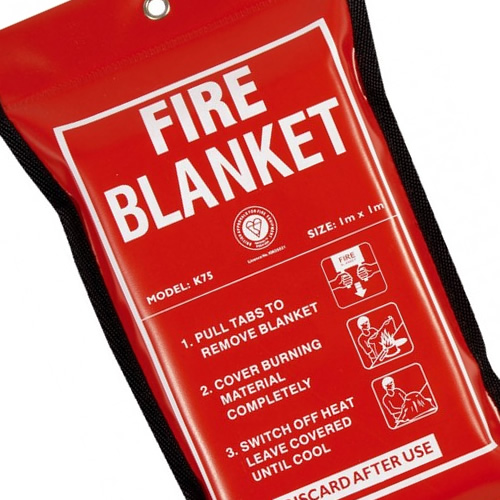 Excellent as assistance for fires involving clothing, Fire Blankets are also excellent for use in working with small cookers and with fires in pots, however should be used with caution, and as with all extinguishers, should only be used by trained operators. Sometimes mistakenly used to attempt to seal fire-rated penetrations in buildings, blankets only have their specific use in kitchens.
Excellent as assistance for fires involving clothing, Fire Blankets are also excellent for use in working with small cookers and with fires in pots, however should be used with caution, and as with all extinguishers, should only be used by trained operators. Sometimes mistakenly used to attempt to seal fire-rated penetrations in buildings, blankets only have their specific use in kitchens.
